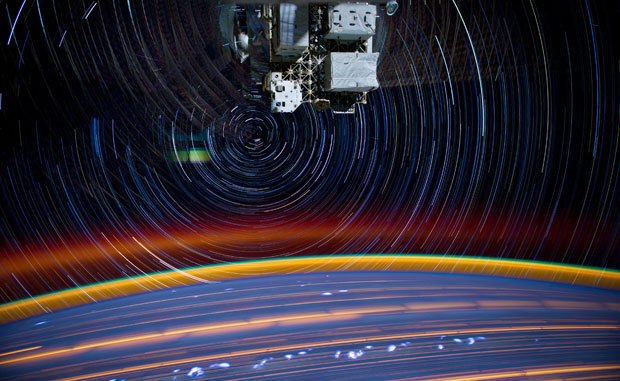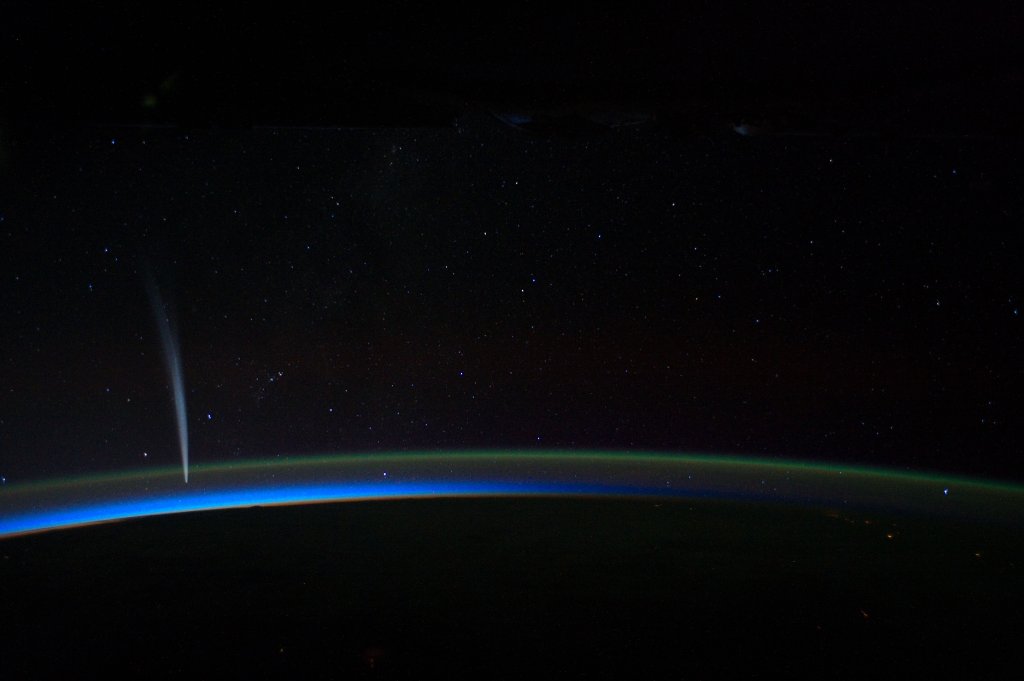

1. 15-minute time-lapse photograph taken from the ISS
From 240 miles above Earth’s surface, you can sense the speed of both the ISS and Earth’s rotation. The star trails -concentric circles- seemingly emanating from the opposite end of the Space Station are a product of the station’s 18,000MPH orbit speed, orbital movement and Earth’s influence.
The mysterious orange line, mimetic of a tropical sunset from Earth’s surface, is known as ‘airglow.’ This phenomenon is believed to owe itself to several causes…
The first is the change in particles present in the upper atmosphere. During daylight, ions present in the Thermosphere and Mesophere of Earth’s atmosphere are photo-ionised by the Sun’s radiation. When solar radiation is substantially reduced, such as night-time, the ions are restored to their natural state, emitting energy as heat and light. The second is believed to be due to a chemical reaction between Hydroxyl, Nitrogen and Oxygen – the resultant glow being chemiluminescence. The final cause is the effect of cosmic rays striking Earth’s atmosphere and ionising atmospheric particles that they impact. The resultant energy loss of the 99.9999% light speed cosmic rays allow a small amount of light to be generated.
Despite this occurring daily, this phenomenon can truly only be appreciated from orbit due to the atmosphere and light pollution interfering with the photons. Plus, the backdrop of the universe finishes the effect off nicely.
Regardless of how it is created, the ability for humankind to be able to live above our planet, in a man-made construct travelling at 18,000MPH and bring us images of our world, images which we will likely never see with our own eyes, is truly magnificent.

2. “Johannes Kepler” Automated Transfer Vehicle-2 Separates from the ISS
That may look like a Star Wars X-Wing, but (sadly) it is not. Here, amidst the blackness of space and the pale light of Earth’s horizon, we see the Automated Transfer Vehicle-2. Admittedly, that name sounds a little bland; however, it was also given the designation Johannes Kepler after the German astronomer and mathematician. This name was selected because the year ATV-2 was named, 2009, was the 400th anniversary of the publication of one of Kepler’s most influential works, Astronomia Nova.
This logistics spacecraft was launched to the International Space Station on 16 February 2011. The spacecraft remained attached to the Space Station for roughly 5 months, until July 2011. At this point, the craft was filled with waste bags and other waste items. Then the ATV-2 deorbited over the Southern Pacific Ocean and perform a controlled reentry. It burned up in the atmosphere on July 21st of that same year.

3. London at Night
This image was taken by ESA astronaut André Kuipers from the International Space Station. Kuipers used the Nightpod to capture this image in 2012 (the year that London hosted the Summer Olympics). The Nightpod tracks the movement of Earth as it basses beneath the ISS at 28,800 km/h, and it is designed to keep any desired target fixed in the middle of the viewfinder. Standard cameras fixed to Nightpod can use longer exposure times, this enables the astronauts to take sharper pictures of cities at night.

4. Comet Lovejoy from the ISS
In this amazing image, Comet Lovejoy blasts past the Earth (just visible near Earth’s horizon). This comet was discovered in November of 2011 by Australian amateur astronomer Terry Lovejoy. From the get-go, scientists did not believe that the comet would have had a happy ending or make another pass by the Earth.
As Lovejoy sped into the Sun’s corona in 2011, passing within just 87,000 miles (140,000 km) of the sun’s surface (well within spitting distance—astronomically speaking), most were assured that the comet would not survive the encounter. Scientists believed that the Sun would consume (melt off) most of the comet’s material. However, the comet managed to withstand the several million degree solar corona for close to an hour, and it headed back out into the solar system.
The photo was taken on Dec. 22, 2011 by NASA astronaut Dan Burbank while he was on the International Space Station

5. Video of Comet Lovejoy from the ISS
International Space Station Commander Dan Burbank captured spectacular imagery of Comet Lovejoy on Wednesday, Dec. 21 (like the image that is pictured above). Burbank described seeing the comet by claiming that it is, “the most amazing thing I have ever seen in space.” He captured hundreds of still images of the comet, which you can see here.

6. This is a picture of the Albert Einstein burning up on reentry
You have no idea how much I wanted to say that. The Albert Einstein ATV is a waste disposal vehicle on board the ISS. The station’s crew crammed it full of waste that can’t be reused (because, the ISS is really good about recycling just about everything). Albert Einstein was filled with dirty clothes, human waste, and generally an assortment of things you’d rather not have dirtying up the ISS.
Albert Einstein was then directed to re-enter Earth’s atmosphere and burn up in one of the coolest ways to “take out the trash” that humanity has come up with to date. The spacecraft disintegrated as planned with nothing to show for it other than a fantastic light show.

7. Aurora from the ISS
This is a time lapse sequences of photographs taken by the crew of expeditions 28 & 29 onboard the International Space Station from August to October, 2011. On Earth, the aurora is a wondrous sight that many travel vast distances to behold. But the view from space is simply incomparable.
The aurora occurs when charged particles from the Sun are blown to Earth on solar winds. These charged particles interact with the Earth’s upper atmosphere and create a bright glow in the sky, which is known as aurora borealis (the northern lights) in the north, and the aurora australis (the southern lights) in the south. Acaba witnessed this amazing display shortly after a particularly strong solar flare.